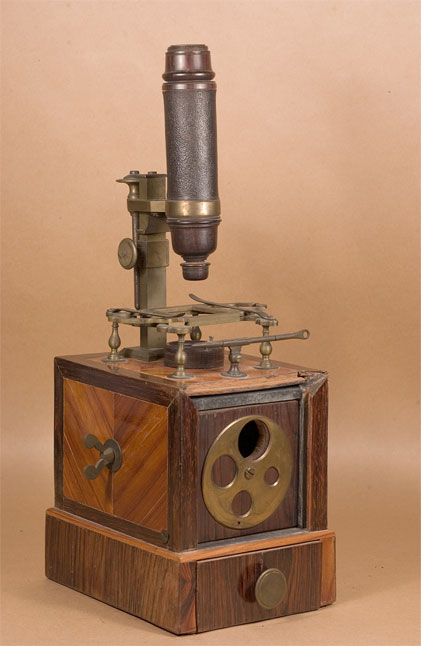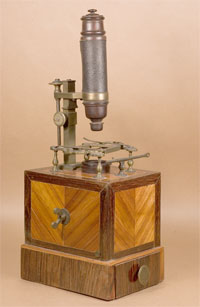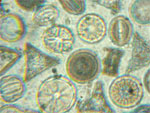 |
|||||
 |
 |
||||
 |
|||||
 |
 |
||||
Passémant Compound Microscope (#129 ) |
|||||||||
 |
Age: c1745 Made by: Claude Siméon Passémant Made in: Paris, France |
||||||||
 |
|||||||||
|
Decorative faceplate in place
|
|||||||||
 |
|||||||||
|
Imaging
|
|||||||||
|
This instrument is a compound box microscope made around 1745 by Claude Siméon Passémant (1702–1769), probably when he was living at the Louvre in Paris. The microscope body tube is made of wood, with the central portion covered in black shagreen. It is supported by a square pillar mounted to an ornate mahogany veneered oak box. The box contains an accessory drawer below, and the illuminating mirror within. The microscope eyepiece and each of the five removable objectives are mounted in dark wood (possibly lignum vitae). The instrument has a Hevelius screw focus adjust. Light intensity to the sample is controlled through the use of an aperture plate on the front of the box. Optics are typical of the 16th and 17th Centuries. It has a three lens system consisting of single, bi-convex eyepiece, field, and objective lenses. Magnification is as much as 100x, however, chromatic aberration is severe and degrades the imaging. It possesses an ornate sample holder with a square opening, presumably to hold a glass plate. On either side are the engravings "Passémant" and "Paris". The holder is held in place by two leaf springs. There is one accessory forceps with this microscope. Box microscopes were especially suited as decorative additions to the salon (Daumas, 1972). Passémant's interest in mechanics started early in life*. He tried several other vocations, however, before settling on instrumentation. He studied at Collége Mazarin, tried and failed at law, and finally set up a haberdashery business. He married at age 31 and immediately turned the business over to his wife so he could devote himself to the study of optics and scientific instrumentation. He published a number of papers on optics (starting in 1738) and precision mechanics. In his shop he constructed a variety of instruments, but mainly reflecting telescopes (he presented one to the Académis des Sciences in 1746). In 1749 he received an award for an astronomical clock, which he later presented to Louis XIV. Due in part to this invention, he was awarded the title of official instrument-maker to the sovereign, and was given a pension and space to live in the Louvre in Paris. Of the microscopes he constructed, most were copies of the Cuff design, which he claimed was his own (a number still exist). He became prominent among scientists through his publications, telescopes, clocks, mechanical globes, and microscopes. For some of these, Passémant claimed fanciful magnifying powers**. His fame was due more to the quality of his workmanship rather than any special technical improvements in his instruments. After his death Passémant's workshop was taken over by his brother-in-law Ollivier, and Nicollet, a workman in his shop. They continued working in the Louvre. This specimen was microscope #42 of the former Nachet Collection. It is very much like another French box microscope (#94; c1740) described by Clay and Court (1932). *Supposedly after having read, when he was 14, L'Usage des globes celestes et terrestres, et des spheres, suivant les différents systèmes du monde, Nicolas Bion (1652-1733), Paris 1699. **One microscope had seven lenses, "of which the last lens magnifies the object up to sixty-four million times" (Daumas, 1972). |
|||||||||
Featured 1/2007, 05/2023